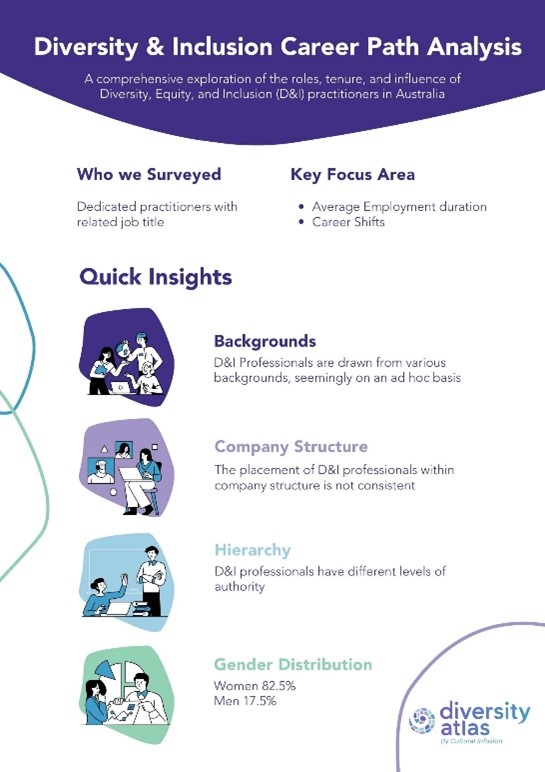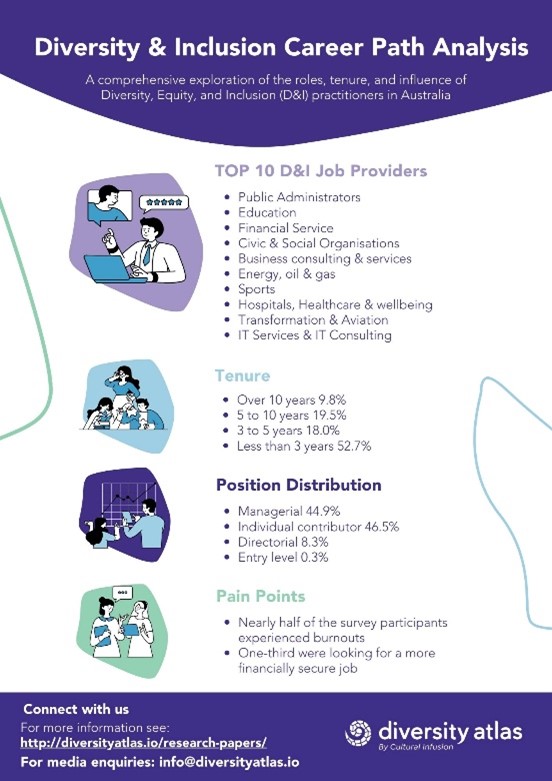
Introduction
In recent years, the significance of Diversity, Equity, and Inclusion (DEI) within organisations has seen exponential growth. No longer just buzzwords, DEI initiatives have become critical to the business strategies of many companies, driven by the well-documented benefits of diverse workforces—enhanced innovation, increased profitability, and improved employee retention. This blog post aims to explore the dynamics of DEI careers, drawing insights from a comprehensive study that analysed the LinkedIn profiles of 1,000 DEI practitioners in Australia.
The Rise of DEI: A Brief Overview
Even a decade ago, the term “Diversity, Equity, and Inclusion” was barely on the radar of most companies. Today, it has become a central focus for many organisations, particularly in the wake of global movements advocating for social justice and corporate accountability. DEI roles have expanded rapidly, not only in terms of the number of positions available but also in the scope and complexity of the responsibilities they entail.
The research at the core of this discussion delves into the career paths of DEI practitioners in Australia, providing a clearer picture of who these professionals are, the industries they work in, the titles they hold, and the challenges they face.
Methodology: Analysing LinkedIn Profiles
The study utilised LinkedIn data to gather information on 1,000 DEI practitioners in Australia. The profiles were categorised into two main groups: “dedicated” DEI practitioners, whose job titles explicitly include terms like diversity, inclusion, equity, and belonging, and “part-time” DEI practitioners, who have DEI responsibilities as part of a broader role. The data collected included demographic information, job titles, industry distribution, and employment history.
This approach allowed for a detailed examination of the professional trajectories of DEI officers, shedding light on their roles, tenure, and the industries that are most invested in DEI initiatives.
Key Findings: The Landscape of DEI Careers in Australia


1. Industry Distribution
One of the most striking findings of the study is the wide range of industries that employ DEI practitioners. While large corporations in sectors like finance, technology, and healthcare are leading the way in DEI efforts, there is also significant representation in industries like education, non-profits, and government. This diversity in industry distribution underscores the universal relevance of DEI initiatives across different sectors.
2. Gender Representation
The study revealed a strong gender imbalance within the DEI field in Australia, with a significant majority of practitioners being female. This trend is consistent with global patterns in DEI roles, where women are often the driving force behind diversity and inclusion efforts. However, the underrepresentation of men in these roles could be indicative of broader societal expectations and the gendered perception of DEI work.
3. Career Progression and Job Tenure
On average, DEI practitioners in Australia tend to have shorter job tenures compared to other professions. This may be attributed to the evolving nature of DEI roles, which are still relatively new and often subject to restructuring within organisations. Additionally, the study found that many DEI professionals come from diverse career backgrounds, with previous experience in human resources, corporate social responsibility, and organisational development. This diversity of experience highlights the interdisciplinary nature of DEI work.
4. The Role of Education and Training
Education and training play a crucial role in the career progression of DEI practitioners. Many professionals in this field hold advanced degrees in areas such as sociology, psychology, and business administration, which provide a solid foundation for understanding the complex social dynamics at play in workplace diversity. Moreover, ongoing professional development, through workshops, certifications, and conferences, is essential for DEI officers to stay updated on best practices and emerging trends.
Challenges and Opportunities in the DEI Field
1. The Evolving Nature of DEI Roles
One of the main challenges identified in the study is the rapidly changing nature of DEI roles. As organisations continue to adapt to new social and economic realities, the expectations placed on DEI practitioners are also shifting. This requires a high level of adaptability and a willingness to continuously learn and grow. For many DEI professionals, this constant evolution can be both a challenge and an opportunity.
2. Navigating Organisational Politics
DEI practitioners often face significant challenges in navigating organisational politics. Implementing meaningful diversity and inclusion initiatives requires not only a deep understanding of social issues but also the ability to influence and persuade key stakeholders within the organisation. This can be particularly challenging in environments where there may be resistance to change or a lack of commitment to DEI goals.
3. Addressing Intersectionality
Intersectionality—understanding how various forms of discrimination (such as those based on race, gender, sexuality, and class) intersect and impact individuals—is a critical component of effective DEI work. However, addressing intersectionality in a meaningful way can be challenging, particularly in organisations that may not fully grasp the complexities involved. DEI practitioners must therefore be skilled in both educating others about intersectionality and designing initiatives that address these overlapping issues.
4. The Importance of Metrics and Accountability
Another challenge for DEI professionals is the need to demonstrate the impact of their initiatives through measurable outcomes. Organisations are increasingly looking for data-driven approaches to diversity and inclusion, which means that DEI practitioners must be adept at using metrics to track progress and justify their efforts. This requires a strong understanding of both qualitative and quantitative research methods, as well as the ability to communicate findings effectively to senior leadership.
The Future of DEI Careers: Trends and Predictions
Looking ahead, the future of DEI careers appears promising, but also fraught with challenges. As the field continues to mature, there will likely be a greater emphasis on formalising DEI roles and career paths, with more standardised job titles, responsibilities, and qualifications. Additionally, as organisations become more global, DEI practitioners will need to navigate increasingly complex cultural dynamics, requiring a more nuanced understanding of diversity across different contexts.
There is also likely to be greater integration of technology in DEI work, particularly in areas like bias detection and inclusive design. Machine learning and artificial intelligence have the potential to revolutionise how organisations approach diversity and inclusion, making it easier to identify and address biases in hiring, promotion, and other key areas.
Finally, the ongoing global conversation about social justice and equity is likely to keep DEI at the forefront of organisational priorities. This means that DEI practitioners will continue to play a crucial role in shaping the future of work, helping to create more inclusive and equitable workplaces for all.
Conclusion: The Critical Role of DEI Practitioners
The role of DEI practitioners is more important than ever in today’s rapidly changing world. As organisations increasingly recognise the value of diversity and inclusion, the demand for skilled DEI professionals is likely to continue growing. However, to be successful in this field, practitioners must be adaptable, politically savvy, and committed to continuous learning.
The insights gained from this study provide a valuable snapshot of the DEI landscape in Australia, highlighting both the opportunities and challenges faced by those in this vital profession. As the field of DEI continues to evolve, it will be essential for practitioners to stay ahead of the curve, leveraging their expertise to drive meaningful change within their organisations.
Leverage our research and materials
Our peer-reviewed research papers are public domain, but all materials and collateral in this section are © Diversity Atlas, 20XX, and are subject to our Terms of Use and Privacy Statement.
Usage of the research is restricted to members of the Diversity Atlas Research Global Community. Non-members should contact us at [email protected] for permission or consider membership. Organizational membership is required for organizational use.
When referencing our research publicly or utilising our materials, proper attribution to Diversity Atlas is mandatory. Formal attribution is required for written references, while verbal references should cite “Diversity Atlas by Cultural Infusion”.
Share this Post